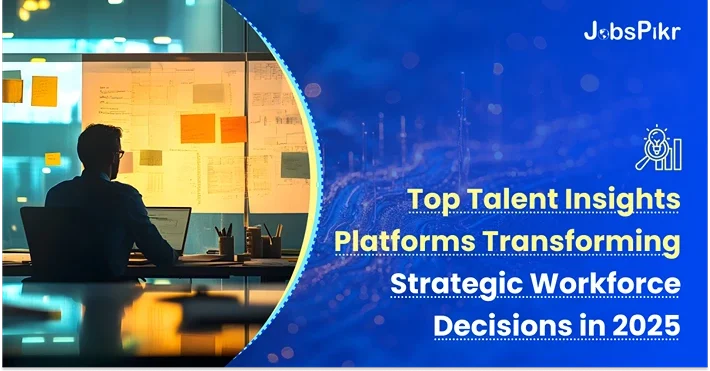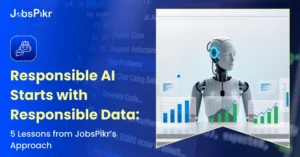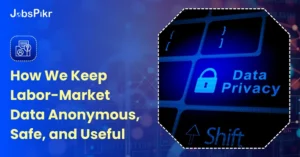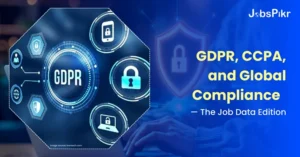- Mining Your Own Backyard: Internal Talent Insights
- Seeing the Whole Playing Field: External Talent Market Insights
- Bridging the Skills Gap: Getting Ready for Tomorrow
- Predicting Who Might Leave (Before They Do)
- The Big Picture: Making Sense of the Whole Journey
- Talent Insights is of Absolute Necessity
You know that feeling? When you’re hiring or trying to develop your team, and it all feels a bit… fuzzy? Like you’re making big decisions based on resumes, a couple of interviews, and honestly, some crossed fingers? Yeah, we’ve all been there. But let’s be real – in today’s world, where skills vanish faster than free coffee in the breakroom and finding great people feels like a constant battle, guessing just doesn’t cut it anymore. You need something sharper. You need talent insights.
Picture talent insights as finally getting the lights turned on in a room you’ve been stumbling around in. Suddenly, you see your team clearly – their real skills, their hidden potential, who’s truly engaged, and how they stack up against the outside world. This clarity? It comes from powerful talent insights platforms.
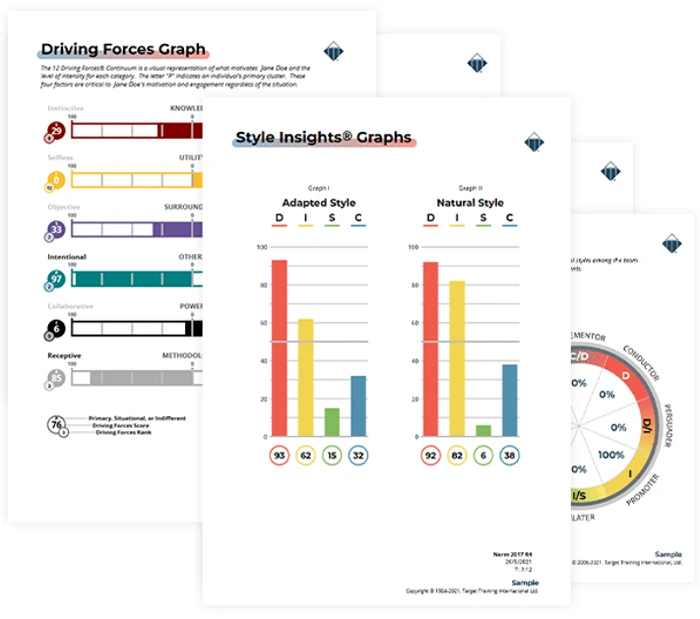
Image Source: TTI Success Insights
Why’s this so critical right now? Skills are expiring faster than ever. Throw in the endless scramble to find and keep good people, plus economic wobbles, and the pressure feels immense. Old-school HR playbooks just buckle under this weight. That’s where modern talent insights solutions step in, fundamentally changing the game for leaders making decisions about their most crucial asset: their people.
Let’s break down the talent insights platforms genuinely moving the needle on workforce strategy this year.
Mining Your Own Backyard: Internal Talent Insights
It sounds almost silly, doesn’t it? Companies spend fortunes hunting externally while amazing talent gathers dust internally. How well do you really know the capabilities lurking beyond job titles in your own org? Internal Talent Intelligence Hubs fix this blind spot. They pull together the data you already have – your HRIS stuff, performance chats, what people are learning, project feedback (handling privacy carefully, obviously).
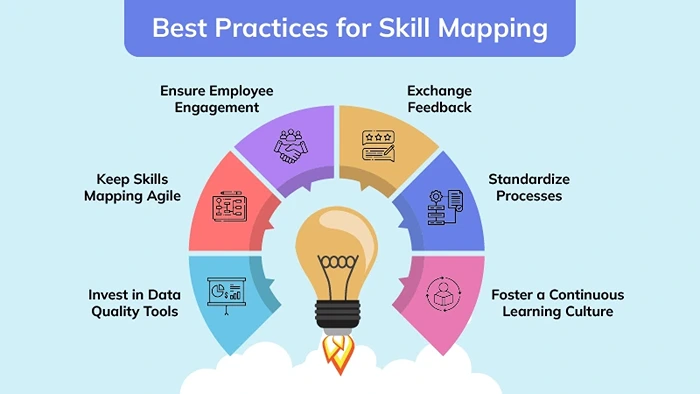
Image Source: AI-Powered Skill Mapping
What Makes Them Click in 2025:
Skills Mapping That Doesn’t Suck: Forget those dusty, outdated job descriptions everyone ignores. These platforms use clever AI to sniff out the skills people actually use based on their real work. It learns constantly.
Career Paths Before the Job Posting Exists: By watching performance trends, learning habits, and listening to people’s own goals, the platform spots realistic internal moves and flags future leaders way before HR gets the resignation email.
Project Matching Magic: Got a hot project needing a weirdly specific skill for three months? The hub finds internal folks who have it, have bandwidth, and might actually want the challenge. Good for speed, great for keeping people from getting bored.
Take a tool like “SkillFlow Dynamics” (a solid talent insights solution). It doesn’t just ask Sally if she knows Python; it quietly checks her actual code commits, project docs, and peer kudos to build a dynamic, verified skills map. Way more honest than self-reported checkboxes.
Why Bother? The Real Answer:
- Save Your Hiring Budget: Filling roles from inside is almost always quicker and cheaper than battling the external market. I recall a BCG study showing internal moves can slash hiring costs by a whopping 60% and seriously help you hang onto your stars.
- Keep Folks Happy (and Staying): People who see a real future inside your walls are way more plugged in. LinkedIn’s data hammers this home – they’re 3.5 times more likely to be engaged. Showing them actual paths matters. A lot.
- Plug Skill Leaks Before You’re Sinking: Spot where your team’s skills are getting thin now so you can train them up before the project implodes.
- Find Leaders Everyone Missed: Unearth high-potential talent from all corners of your company, objectively, using data, not just who plays golf with the boss.
Seeing the Whole Playing Field: External Talent Market Insights
Getting your own house in order is step one. But step two? Understanding the massive, chaotic talent ocean outside. Who’s available? What do they really cost? What skills are actually out there? Where are they hiding? External Talent Market Intelligence Platforms make sense of the chaos, pulling data from job boards, LinkedIn, salary surveys, company gossip sites, and even university pipelines.
Cutting Through the Noise in 2025:
- Insights So Local: Get salary ranges, talent pool depth, and competitor poaching activity down to specific zip codes or remote-work hotspots. Critical for deciding where to hire or how much to offer without getting laughed at.
- Predicting Where Talent’s Flowing: See patterns – are developers fleeing FinTech for ClimateTech? Are data scientists suddenly loving Austin? This helps you see shortages in your critical skills coming months. Phew.
- Competitor Stalking (The Legal Kind): Figure out what your rivals are really doing talent-wise. What skills are they hoarding? Where are they opening offices? Maybe spot a weakness, like crazy high turnover in their customer support hub. Interesting.
- Spotting the Next Big Thing: Catch weird, emerging skills (like “prompt engineering” for AI) way before they hit the mainstream job boards. Gives you time to skill up or hire before the bidding wars start.
Why This Wins You Talent:

Image Source: Job Skills in Demand
- Hire Smarter, Save Your Sanity: Set salaries that won’t get rejected, pick sourcing locations that make sense (remote or not), and time your hiring pushes so you’re not shouting into the void. Budget breathes easier.
- Actually Land Those Unicorn Hires: Understand what truly makes the people you want tick, beyond cash. Is it flexibility? Impact? Free snacks? Craft an offer that resonates.
- Make Big Bets With Confidence: Use talent market insights to guide expansion (“Do they have the skills we need in Bangalore?”), acquisitions (“What’s really in their talent cupboard?”), or even product roadmaps (“Can we even find people to build this?”).
- Dodge Talent Disasters: See potential skill shortages looming like storm clouds before they wash out your launch plans.
Bridging the Skills Gap: Getting Ready for Tomorrow
Honestly, this might be the killer app for talent insights. It’s about ruthlessly identifying the gap between what your team can do today and what your business desperately needs them to do tomorrow. This isn’t ordering a generic “Python for Beginners” course. It’s core, strategic workforce planning. Skills Gap Analytics Platforms smash together your internal skills data, external market trends, and your own business ambitions.
How They Tackle the Future Now:
- Linking Skills to Strategy (No BS): The platform takes a concrete goal (“Launch our AI-powered fraud detection Q4”) and spells out the exact skills needed to pull it off, highlighting where you’re short right this second. Brutal, but necessary.
- The Build, Buy, or Bot Dilemma: Clever AI helps untangle the best path for each gap: Train Brenda internally (Build)? Hire a hotshot externally (Buy)? Or can a clever bot do it (Bot)? It weighs cost, speed, and long-term pain.
- Learning Paths That Don’t Bore People to Tears: For the “Build” route, it crafts personalized journeys – mixing internal docs, the right Coursera/Udemy courses, bite-sized nuggets, and real-world stretch assignments. No more useless, generic training.
- Playing Fortune Teller (Safely): Test scenarios. “What if regulation changes kill Project X?” “What if we acquire Startup Y?” See the ripple effects on your skills gaps and what you’d need to scramble for.
Why This Saves Your Day:
- Stop the Fire Drills: Shift from desperately patching holes to calmly building the workforce you know you’ll need. Hiring for critical tech roles often takes 30+ days and costs over $4k per hire (IBM’s got the receipts) – growing internally is usually faster and cheaper. Fact.
- Stop Wasting Training Cash: Laser-focus your L&D budget on the skills that deliver real strategic bang. No more throwing money at flavor-of-the-month certifications.
- Move Like the Wind: Close critical gaps fast so you can pivot or seize opportunities without your team hitting a skills wall.
- Make Employees Feel Invested In: Giving people a clear, personalized path to learn future-proof skills. That’s pure retention gold. People stick around where they grow.
Predicting Who Might Leave (Before They Do)
Losing a top performer? Oof. It stings. It’s not just the recruiter fee; it’s the lost momentum, the tribal knowledge walking out, the team morale nosedive. Exit interviews? They’re autopsies. They tell you why they left, not why they might. Predictive Flight Risk tools use talent management insights to spot who’s getting restless before they polish their resume.

How They Work Their Magic in 2025:
- Connecting Weird Dots: These platforms look at a messy mix: Trends in engagement scores (not just the last survey), the tone of manager feedback, pay competitiveness, promotion history, whispers of manager friction, workload stress signals, even subtle drops in collaboration patterns. It’s the whole picture.
- Explaining the “Why” Behind the Risk: It’s not just a scary red number. It suggests reasons: “Pay’s 20% below market for their expertise,” “Topped out in role for 4 years despite stellar reviews,” “Stopped contributing to the key project Slack channel.”
- Action Plans, Not Panic: Based on the likely drivers, it tells managers/HR exactly what to try: A serious career path talk? A spot bonus? Shifting some work off their plate? Meaningful recognition? Fix the root cause, not the symptom.
- Arming Managers Simply: Managers get clean dashboards showing flight risks on their team with clear, actionable “Here’s what to do” nudges. Empowers them to actually manage retention.
The Bottom Line Impact:
- Hold Onto Your MVPs: Proactively keep your irreplaceable people and critical skill holders. Replacing someone often costs 1.5 to 2 times their annual salary. SHRM’s said it for years. That’s real money walking out the door.
- Spend Retention Cash Wisely: Target your efforts (bonuses, plum projects, development spots) where they’ll actually make a difference. Blanket pizza parties don’t retain stars.
- Make Managers Retention Heroes: Give them the insights and simple tools to actively keep their team happy and engaged. Huge win.
- Show People They Matter: Fixing things before someone quits screams “We value you!” and builds fierce loyalty.
The Big Picture: Making Sense of the Whole Journey
Let’s face it, an employee’s experience is a million tiny interactions – applying, onboarding, using clunky tools, getting feedback (good and bad), learning stuff, collaborating (or not), even leaving. Unified Talent Experience (UTX) Analytics Platforms grab data from all these scattered touchpoints to show you the whole, messy, beautiful picture.
How It Cuts Through the Fog:
- Finding the Friction Points: Map the entire employee journey visually. See exactly where people grind their teeth – like a 10-page application form, waiting 3 days for laptop access, or radio silence after the 90-day mark. Pain points revealed.
- Listening to the Murmur: Go beyond survey scores. Analyze the feeling in open comments, team chat channels, IT support tickets, and even communication patterns. Get the real-time vibe check.
- Connecting Experience Dots to Business Results: Find the powerful links. Does a smooth first week lead to faster ramp-up? Does using the internal mentorship program correlate with sticking around longer? UTX finds these golden threads.
- Personalized Support, Right on Time: Let HR or managers offer timely, relevant help based on where someone is and what the data whispers they might need (e.g., pushing stress management resources during end-of-quarter crunch time).
Why Seeing the Whole Picture Rocks:
- Fix What Actually Hurts: Stop guessing how to improve EX. Use data to see which tweaks will genuinely boost engagement, output, and retention. No more shot-in-the-dark initiatives.
- Get HR Out of Their Silos: Force recruiting, HRBPs, L&D, and Comp to look at the same employee journey map and its potholes. Shared pain, shared solutions.
- Turn Employees into Fans: A consistently good experience makes people stay and rave about you. That’s free, powerful recruiting.
- Smooth Out the Daily Grind: Find and fix internal process logjams that waste time and frustrate everyone. Unblocked, happy employees simply achieve more. Common sense, proven by data.
Talent Insights is of Absolute Necessity
Let’s wrap this up. Navigating work in 2025 without talent insights? That’s like sailing a stormy sea without instruments. Gut feelings and clunky old HR processes won’t protect your bottom line or competitive edge. Talent insights, powered by serious talent insights platforms, deliver the clarity, foresight, and actionable intelligence you need to navigate confidently.
These platforms – helping you unlock internal gems, understand the wild external market, bridge scary skills gaps, predict who might jump ship, and smooth the whole employee ride – aren’t just changing HR. They’re turning it into the strategic powerhouse it always should have been. The strategic talent management insights they provide let leaders:
- Hire with precision, not just panic.
- Proactively build skills for the unknown.
- Keep their irreplaceable people.
- Deploy talent with purpose and agility.
- Drive business results you can actually measure.
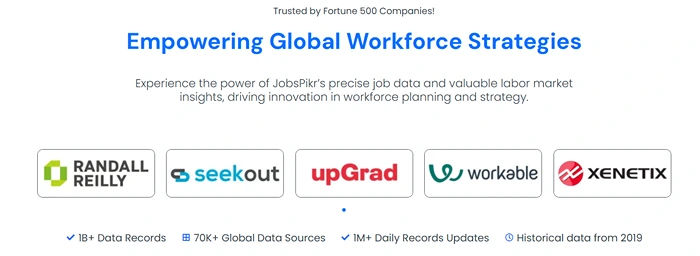
Try JobsPikr today to see talent insights and jobs data in action for all the metrics and information troves that matter to you.
